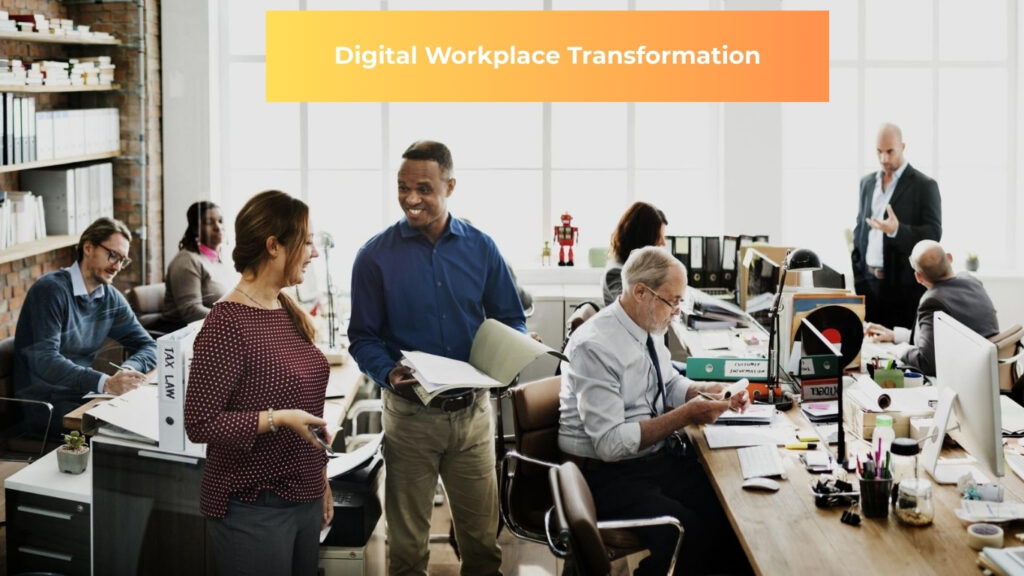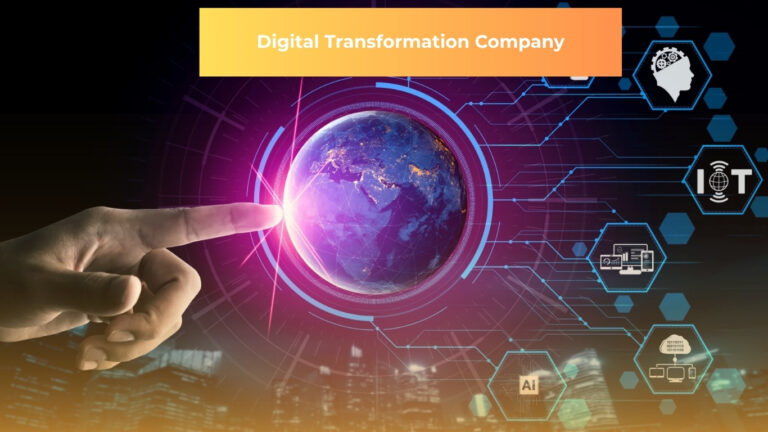Digital workplace transformation is reshaping how businesses operate, leveraging technology to boost productivity and collaboration. With the global workplace transformation market valued at USD 25,465.2 million in 2024 and is projected to reach USD 69,890.1 million by 2030, digital workplace transformation is a critical strategy for staying competitive.
This article explores how digital workplace transformation enhances efficiency, addresses global IT challenges, and drives innovation, with insights into HBLAB’s AI-driven workplace solutions.
What is Digital Workplace Transformation?

Digital workplace transformation involves integrating advanced technologies to modernize work environments, enhancing collaboration, efficiency, and innovation. Unlike traditional setups, digital transformation workforce strategies leverage cloud computing, AI, and IoT to create agile, connected workplaces. For example, cloud-based platforms enable seamless remote collaboration, transforming how teams operate globally.
This process goes beyond tools, fostering a culture of continuous learning and adaptability. Digital workplace transformation empowers organizations to meet evolving customer expectations and attract tech-savvy talent, addressing universal challenges like talent shortages and cost pressures. It’s a strategic shift for future-ready businesses.
🌟 Explore HBLAB’s digital transformation solutions!
How Digital Workplace Transformation Works
Digital workplace transformation redefines how organizations operate by weaving advanced technologies, streamlined processes, and empowered people into a cohesive framework. This structured approach drives digital workplace transformation, enabling businesses to boost productivity, foster innovation, and adapt to dynamic market demands.
By integrating cutting-edge tools with human-centric strategies, digital workplace transformation creates agile, connected work environments. Below is a detailed breakdown of how digital workplace transformation unfolds:
Assessment and Vision Definition
Digital workplace transformation begins with a thorough evaluation of existing workflows, systems, and pain points. Organizations use tools like digital maturity assessments to pinpoint inefficiencies, such as siloed data or manual reporting.
A clear vision is then crafted, aligning digital workplace transformation with goals like enhanced collaboration or faster decision-making. For example, a retailer might identify slow inventory updates as a bottleneck and set a goal to implement real-time analytics, guiding the transformation journey.
👉 Get our in-depth IT communication guide now—free to download.
Technology Integration
Scalable digital transformation solutions are deployed to modernize operations. Cloud platforms like Microsoft 365 enable digital transformation in workforce communication by providing real-time collaboration tools, such as shared workspaces and video conferencing. AI-driven chatbots, integrated into platforms like Slack, automate routine queries, freeing employees for strategic tasks. Digital workplace transformation leverages low-code platforms to rapidly develop custom apps, ensuring seamless integration with existing systems and accelerating adoption.
Process Optimization
Digital workplace transformation reengineers workflows to eliminate inefficiencies. Robotic Process Automation (RPA) streamlines repetitive tasks, like invoice processing, reducing errors and cycle times. For instance, an RPA bot can automate order approvals, syncing data across ERP systems in real-time. By redesigning processes with digital workplace transformation, organizations achieve leaner operations, boosting productivity and responsiveness to market changes.
🌟 Explore HBLAB’s digital transformation solutions!
Employee Enablement
Digital transformation requires workforce transformation, making employee training critical for digital workplace transformation. Interactive microlearning modules teach staff to use AI tools, such as predictive analytics dashboards, effectively. Gamified training platforms, integrated into digital workplace transformation, engage employees by rewarding progress, ensuring high adoption rates. For example, a sales team might use VR simulations to practice client pitches, enhancing skills and confidence.
Continuous Improvement and Analytics

Digital workplace transformation thrives on iterative refinement. Feedback loops, powered by AI-driven analytics, track KPIs like employee engagement or process efficiency. Real-time dashboards visualize data, enabling leaders to adjust strategies dynamically. For instance, a manufacturing firm might use IoT sensors and AI-driven workplace solutions to monitor equipment performance, refining maintenance schedules to minimize downtime. This ensures digital workplace transformation delivers sustained value.
Cultural Alignment and Change Management
Digital workplace transformation embeds a culture of innovation by aligning technology with human needs. Change management strategies, like persona-based workshops, address employee concerns and foster buy-in. For example, a global firm might use digital townhalls to showcase digital transformation in workforce communication, encouraging adoption. By prioritizing cultural shifts, digital workplace transformation ensures long-term success.
For example, a logistics company implementing digital workplace transformation might integrate IoT sensors with a cloud-based ERP system to track shipments in real-time, using AI-driven workplace solutions to predict delays. This framework drives measurable outcomes, aligning with business objectives.
🚀 Discover how HBLAB powers digital workplace transformation!
Advantages of Digital Workplace Transformation
Digital workplace transformation delivers significant benefits, addressing global IT challenges:
- Enhanced Productivity: Digital transformation workforce tools automate repetitive tasks, boosting efficiency. Cloud platforms reduce manual data entry, saving time.
- Improved Collaboration: Digital transformation in workforce communication enables real-time teamwork via platforms like Slack, fostering innovation.
- Increased Satisfaction: How does digital transformation increase workforce satisfaction? Flexible work arrangements and intuitive tools improve morale and retention.
- Cost Efficiency: Cost-effective digital workplace solutions reduce operational expenses through automation and remote work capabilities.
- Customer Experience: Digital workplace transformation enhances responsiveness, delivering personalized solutions to meet customer demands.
These advantages make digital workplace transformation essential for competitive businesses.
Challenges and Risks of Digital Workplace Transformation
Digital workplace transformation faces several challenges:
- Resistance to Change: Employees may resist new tools due to unfamiliarity. Digital transformation requires workforce transformation through training to overcome this.
- High Costs: Implementing scalable digital transformation requires investment in technology and training, challenging smaller firms.
- Security Risks: Increased connectivity raises cybersecurity concerns. Robust measures, like GDPR compliance, are critical for digital workplace transformation.
- Skill Gaps: Employees may lack expertise in new technologies, requiring upskilling.
- Integration Issues: Legacy systems may not align with modern tools, complicating digital workplace transformation.
Addressing these with strategic planning ensures successful digital workplace transformation. 👉 Contact HBLAB to navigate transformation challenges!
Role of Emerging Technologies in Digital Workplace Transformation
Emerging technologies—AI, cloud, IoT, and AR—are the primary engines of digital workforce transformation, reshaping communication, productivity, skills, and satisfaction in measurable ways across the modern enterprise. Together, these technologies show that digital transformation requires workforce transformation to capture value, mitigate disruption, and lift productivity at scale.

What changed for the workforce
Digital workforce transformation is accelerating job task redesign, skills shifts, and role mix changes as automation and augmentation spread through knowledge work and operations. The World Economic Forum’s Future of Jobs analysis highlights rapid technology adoption and the need for continuous upskilling and reskilling to align the digital transformation workforce with emerging roles and capabilities.
AI as the catalyst
AI now automates or augments work activities that account for 60%–70%60%–70% of employees’ time, signaling a structural shift in the anatomy of work and the digital transformation workforce operating model.
Generative AI alone could add $2.6–$4.4 trillion annually, with roughly 75% of impact concentrated in customer operations, marketing and sales, software engineering, and R&D—core levers of digital workforce transformation outcomes.
Cloud and communication
Cloud computing underpins digital transformation in workforce communication by enabling secure, anywhere access to collaboration, content, and AI copilots embedded in productivity suites, which is critical for hybrid and distributed teams.
In 2024, Microsoft’s Work Trend Index reported AI at work has gone mainstream, with usage nearly doubling in six months and 75% of global knowledge workers using AI—signaling cloud-scale adoption patterns that reshape the digital transformation workforce.
IoT in operations
IoT connects assets, people, and spaces to deliver real-time telemetry, predictive maintenance, and safety monitoring, tightening the human–machine loop in the digital workforce transformation of frontline and industrial workflows.
By 2030, IoT could enable $5.5–$12.6 trillion in value, reinforcing that digital transformation requires workforce transformation in data literacy, human-in-the-loop supervision, and exception handling across connected environments.
AR for training and adoption
AR/VR accelerates workforce upskilling with immersive simulations that shorten time-to-competence and improve retention—pillars of digital workforce transformation at enterprise scale.
In controlled studies, learners completed training 4x faster, were 275% more confident applying skills, and reported 3.75x greater emotional connection to content versus classroom training, directly improving digital transformation workforce enablement and adoption.
Workforce satisfaction and hybrid work
Hybrid models illustrate how digital transformation in workforce communication and collaboration can sustain performance while improving satisfaction and retention—a key “how does digital transformation increase workforce satisfaction” outcome.
A randomized trial and subsequent peer‑reviewed analysis found hybrid work did not harm performance and improved retention and job satisfaction, reducing quit rates by roughly one‑third in related evaluations, which complements AI‑ and cloud‑enabled ways of working.
Requires workforce transformation
Because digital transformation requires workforce transformation, organizations must commit to role redesign, skills mapping, and reskilling at scale to mitigate displacement risk and realize productivity gains.
Future of Jobs research emphasizes structured workforce strategies—skills taxonomies, learning ecosystems, and internal mobility—to align digital workforce transformation with evolving tech adoption curves.
How emerging tech drives outcomes
- Artificial Intelligence: Automates routine cognition, augments decision cycles, and concentrates value in customer operations, marketing, engineering, and R&D, materially changing how the digital transformation workforce creates output.
- Cloud Computing: Scales secure access to data, copilots, and workflows across geographies, enabling digital transformation in workforce communication and collaboration for hybrid teams.
- Internet of Things: Streams real-time signals that reconfigure work design around exception handling, remote operations, and predictive interventions in digital workforce transformation programs.
- Augmented/Virtual Reality: Compresses time-to-skill and increases training effectiveness, accelerating adoption of new tools and processes within the digital transformation workforce.
Implementation blueprint
Strategy: Tie AI, cloud, IoT, and AR investments to role-level value maps and productivity hypotheses to direct digital workforce transformation where impact concentrates.
Skills: Build a living skills taxonomy and reskilling pathways that anticipate tech diffusion rates and automate–augment splits across functions and job families.
Operating model: Standardize secure, cloud-first collaboration and data access; harden change management and measurement to convert experimentation into business impact.
Adoption: Use immersive training for new tools and processes to reduce time-to-competence and raise confidence in the transformed workforce.
When to Use Digital Workplace Transformation?
Digital workplace transformation excels in scenarios requiring agility and efficiency:
- Remote Work Enablement: Digital transformation in workforce communication supports hybrid teams with cloud tools.
- Process Automation: AI-driven workplace solutions streamline repetitive tasks, ideal for high-volume operations.
- Customer-Centric Operations: Digital workplace transformation enhances responsiveness to market demands.
- Talent Attraction: How does digital transformation increase workforce satisfaction? Modern tools attract tech-savvy employees.
- Sustainability Goals: Cost-effective digital workplace solutions reduce resource use, aligning with green initiatives.
HBLAB – Your Partner in Digital Workplace Transformation
HBLAB is a leader in digital workplace transformation, delivering AI-driven workplace solutions to global businesses. With 630+ professionals, including 30% senior-level experts with over 5 years of experience, HBLAB combines technical expertise with business insight. Our CMMI Level 3 certification ensures process excellence, while our AI expertise since 2017, including partnerships with VNU’s Institute for AI, drives innovation.

HBLAB’s flexible engagement models—offshore, onsite, or dedicated teams—offer cost-effective digital workplace solutions, saving up to 30% compared to in-house development. From cloud integration to AI automation, our scalable digital transformation services align with your goals, ensuring compliance with GDPR and ISO 27001. Whether modernizing remote work or streamlining processes, HBLAB empowers your digital transformation workforce for success.
🚀 Contact HBLAB for digital workplace transformation solutions today!
Conclusion
Digital workplace transformation revolutionizes work, enhancing productivity, collaboration, and customer engagement. From AI-driven workplace solutions to scalable digital transformation, it addresses global challenges like talent shortages and cost pressures. How has digital transformation changed the landscape for the workforce? With HBLAB’s expertise, businesses can build agile, future-ready workplaces. 👉 Start your digital workplace transformation with HBLAB!
FAQs
1. What are the 5 essential components of digital transformation?
A practical, evidence‑aligned stack is strategy and governance, people and skills, data and architecture, technology platforms, and processes and ways of working, reflecting WEF’s workforce strategies, McKinsey’s technology and data emphasis, and Microsoft’s AI adoption at scale in cloud collaboration contexts. This structure ensures digital workforce transformation aligns leadership, talent, data, and platforms so value creation and adoption are measurable and sustainable.
2. What are the 4 pillars of digital transformation?
Harvard Business Review outlines four pillars—IT uplift, digitizing operations, digital marketing, and new digital growth—to structure transformation initiatives from core systems to growth bets. These pillars can be mapped to digital workforce transformation by aligning skills, operating models, and measurement for each pillar to realize outcomes, not tools.
3. What is digital workforce transformation?
Digital workforce transformation is the integrated redesign of roles, skills, workflows, and culture to harness AI, cloud, IoT, and immersive technologies for measurable productivity, quality, and experience gains. It operationalizes the principle that digital transformation requires workforce transformation to capture value while maintaining employability and satisfaction.
4. What is the most difficult part of digital transformation?
Moving from experimentation to business impact—governance, data readiness, operating‑model change, and adoption at scale—is consistently identified as the hardest part by large, multi‑country panels like Microsoft’s Work Trend Index 2024. This is where digital workforce transformation practices, skills, and change management either convert pilots into outcomes or stall.
5. What are the four main areas of digital transformation?
Commonly framed areas include organization transformation, moving from waterfall to agile, customer‑centered approaches, and integrating emergent technologies, each requiring aligned workforce strategies and metrics. These areas connect directly to digital workforce transformation in how teams are structured, how work is delivered, and how technology is embedded into daily flow.
6. What are the 3 P’s of digital transformation?
Widely cited 3 P frameworks emphasize People, Processes/Products, and Platforms/Technology, reflecting that workforce, operating mechanisms, and enabling systems must evolve together. In digital workforce transformation, People and Processes determine adoption velocity while Platforms provide the scalable substrate for AI and data‑driven work.
7. What are the 6 D’s of digital transformation?
The Six Ds of exponential technologies—digitization, deception, disruption, demonetization, dematerialization, and democratization—describe how digital technologies evolve and upend industries, with downstream effects on skills and work design. Understanding these phases helps sequence digital workforce transformation strategies ahead of disruption waves.
8. What are the factors affecting digital transformation?
Macro factors include technological change, geoeconomic fragmentation, economic uncertainty, demographic shifts, and the green transition, all shaping jobs, skills, and employer practices through 2030. Execution factors include AI readiness, data quality, cloud adoption, and change management capacity, which determine digital workforce transformation speed and impact.
9. Why do most digital transformations fail?
Failures typically stem from unclear value hypotheses, fragmented data, inadequate skills and change management, and inability to scale beyond pilots—gaps highlighted across WEF workforce strategies and enterprise AI adoption research. Addressing these with rigorous governance, skills pathways, and product‑like operating models increases the odds of digital workforce transformation success.
10. What are the three main stages of digital transformation?
A pragmatic view is discover and pilot, scale and industrialize, and sustain and optimize, mirroring research that the “hard part” is scaling for impact and embedding new ways of working. Each stage requires corresponding digital workforce transformation moves—from skills discovery and experimentation to role redesign and continuous upskilling at scale.
11. What is the most critical success factor for digital transformation?
The most critical factor is aligning people and skills with clear business outcomes and operating‑model change, because digital transformation requires workforce transformation to realize value from AI, cloud, IoT, and data. Evidence shows organizations that match technology bets with skills, adoption, and governance scale faster and sustain impact longer.
CONTACT US FOR A FREE CONSULTATION
Read more:
–Software Frameworks Explained: 6 Unstoppable Benefits for Modern Teams
– Agentic AI In-Depth Report 2025: The Most Comprehensive Business Blueprint
– AI in Ecommerce (2025): Extraordinary Trends Redefining Online Shopping Worldwide


